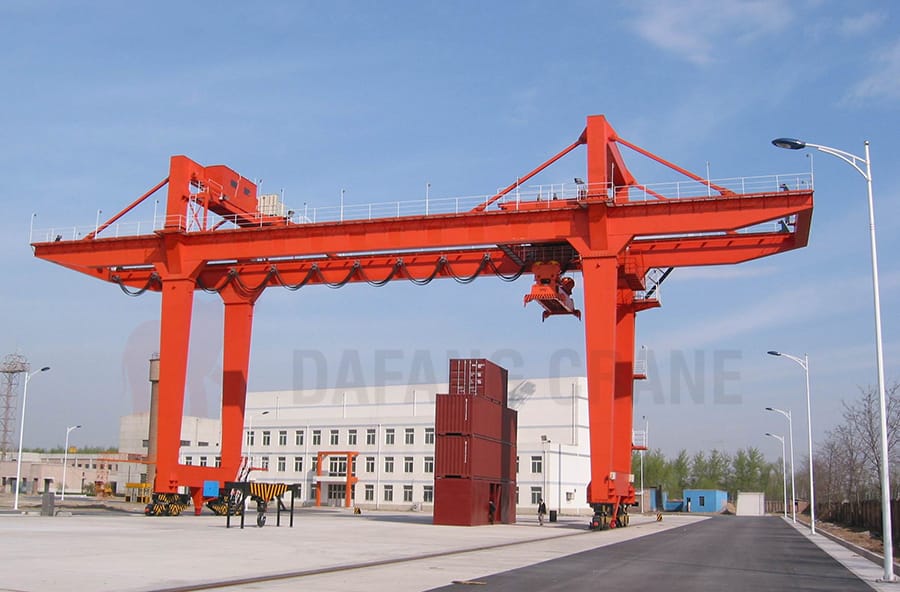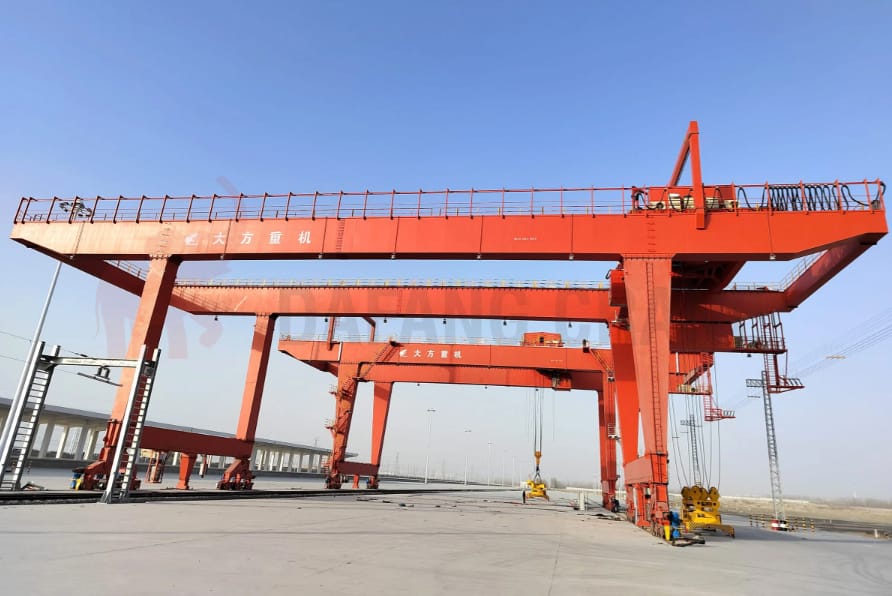Rail Mounted Gantry Crane: Work And Maintenance
Rail-mounted gantry cranes, also known as RMGs, are essential pieces of equipment used in various industries for efficient material handling. These cranes are commonly found in ports, intermodal terminals, and manufacturing facilities. In this article, we will explore the work process and maintenance aspects of rail-mounted gantry cranes, understanding the key components and procedures involved.
What Is Rail Mounted Gantry Crane
Rail Mounted Gantry crane is a type of heavy-duty material handling equipment commonly used in ports and container terminals. This specialized crane is designed to move shipping containers from one location to another with precision and efficiency. RMG cranes are typically mounted on rails, allowing them to traverse the length of the terminal and position containers at specific storage locations or onto trucks for transport. These cranes are equipped with lifting mechanisms and spreader bars that can handle multiple containers at once, increasing productivity and reducing handling time. With their robust construction and advanced control systems, RMG cranes play a vital role in the logistics industry by facilitating the smooth flow of goods and improving overall operational efficiency.

Work Process Of Rail-Mounted Gantry Cranes
Rail-mounted gantry cranes (RMGCs) are widely used in container terminals and ports for efficiently handling and stacking shipping containers. The work process of a rail-mounted gantry crane typically involves the following steps:
- Positioning: The RMGC is initially positioned at a designated starting point along a set of parallel rails. The rails are installed on the ground or elevated structure to create a defined working area.
- Power On: The crane operator powers on the RMGC, ensuring all necessary systems, such as electrical, hydraulic, and safety mechanisms, are functioning correctly.
- Traveling: The RMGC moves along the rails using wheels or caterpillar tracks. It can be controlled manually by an operator from within the cabin or automated through a computerized control system.

- Container Pickup: Once the RMGC reaches the desired location where a container needs to be lifted, it positions itself above the container. The crane is equipped with spreader beams that can be adjusted to fit different container sizes.
- Lifting: The crane’s lifting mechanism, which usually consists of wire ropes and hoisting drums powered by electric motors, engages the spreader beams and lifts the container off the ground. The hoisting speed and capacity depend on the crane’s specifications.
- Transporting: With the container securely lifted, the RMGC starts moving while carrying the container. It travels along the rails to its intended destination, such as a designated stacking area, or another mode of transportation, such as a truck or a ship.
- Stacking or Placement: When the RMGC reaches the desired location, it lowers the container onto the ground or onto another stack of containers. The operator ensures proper alignment and placement of the container to prevent accidents or damage.
- Release and Return: After placing the container, the RMGC releases the container by disengaging the spreader beams. It then returns to its starting position or proceeds to the next container for handling, depending on the operational requirements.
- Repeat: The RMGC continues this process, picking up and transporting containers according to the terminal’s demands until all tasks are completed or until instructed otherwise.
Maintenance Of Rail-Mounted Gantry Crane
Here are some aspects to consider for the maintenance of a rail-mounted gantry crane:
Bridge Structure And Maintenance
- Crane's bridge structure and main metal structure should make completed inspection annually.
- Check all the connected bolts, and there is forbidden to have any loose;
- Check main welding line, and if there is any crack, should eradicate and reweld with good electrode, ensure the weld quality;
- Should repair other main mechanisms if there is any transformation;
- Crane and trolley's travel rail should be checked twice every year, and check rail's firm situation, and mutual position, adjust them if there is any difference. Should replace the rail if the rail side's abrasion more than 15% of original rail.

Wire Rope's Check And Maintenance
Should regularly check the wire rope's fix situation on the end, and the wire rope's broken line and abrasion. If there are any of the following situations, should handle them as soon as possible: wire rope's diameter becomes thin, elasticity becomes small, or other transformation etc. Should keep the wire rope in good lubricant situation, and should remove the dirt first before making lubricating, and cleaning it with kerosene, then heat the grease to more than 80 ℃, so that the oil can immerse into the wire rope.
Power Supply Rail(Power Supply Cable)
Should keep the power supply cable surface's clean, and the insulator should be whole, and tightly be fixed on the support beam. If there is fire means bad contact, this may due to power supply rail and cable trolley's loose connection or dirty surface. Should regularly check cable's wrong situation and soft cable, trolley, and drum's right work.
Crane And Trolley Travel Mechanism
- Rail Gnawing: This means that the wheel rim seriously contact with rails, and have large sounds or shake during travel. For example, if there is rail gnawing on same direction, should readjust the wheel's horizontal decline, and let the two driving wheel(or driven wheel)'s decline opposite. If the rail gnawing is opposite during travel, then this may due to motor or brake's asynchronous; if there is rail gnawing on some rails, maybe there is problem of wheel or span. If there is trolley rail gnawing, this normally due to main girder's sink, which arouse main girder's inward bend. If the bend is not very serious, should adjust wheel's gauge; but if the bend is very seriously, should repair the main girder, and do not easily change rail.
- Main driving wheel Slip: If there is wheel slip, should check whether main driven wheel and rail are contact, or should add washer to adjust angle gear box. If the slip is due to grease, should scatter some fine sand to enlarge the friction. Then should adjust the braking torque to forbid sudden brake.
Brake
Brake should be tested between the shaft, and the travel brake needs to be tested every 2/3 month and should confirm whether all the brake mechanism is flexible, whether there is oil leak during the check. When braking, the brake tile needs correctly cling to the brake wheel, and the connecting surface should large more than 75%. When it opens, the gap of the brake wheel's side should be the same. Check brake torque, and for the lift mechanism, the brake have to effectively stop 1.25 times lift capacity. For the travel mechanism, between the rated brake distance, can ensure brake crane or trolley, the brake distance is determined by work operation. If the brake washer abrasion is more than 30% original of original one, should replace it. If the brake wheel have more than 0.5mm dent or scratch, have to make modification. Should clean the brake wheel's surface with kerosene timely. When there is burnt odor or smoke, should timely adjust the brake wheel's gab, and make the gab is same. All the connections of brake wheel, every week should make the lubrication, so that it can be in good condition.
FAQs
- What is a rail-mounted gantry crane?
A rail-mounted gantry crane is a type of crane that operates on a rail system. It is commonly used in ports, shipping yards, and warehouses for lifting and moving heavy loads. - How does a rail-mounted gantry crane work?
A rail-mounted gantry crane works by using a combination of hoisting, trolley, and travel mechanisms. The hoist lifts the load, while the trolley moves it horizontally along the gantry beam. The entire crane can also move along the rails to position the load accurately. - How often should a rail-mounted gantry crane be maintained?
The frequency of maintenance depends on factors such as the intensity of crane usage, operating conditions, and manufacturer recommendations. Generally, regular inspections should be conducted, with more comprehensive maintenance performed annually or as suggested by the crane manufacturer. - Can I perform maintenance on a rail-mounted gantry crane myself?
Maintenance tasks for a rail-mounted gantry crane should ideally be carried out by qualified technicians or professionals experienced in crane maintenance. They have the necessary knowledge and expertise to identify potential issues accurately and ensure the crane is properly serviced and safe to operate.
Send Your Inquiry
- Email: sales@hndfcrane.com
- WhatsApp: +86-191 3738 6654
- Tel: +86-373-581 8299
- Fax: +86-373-215 7000
- Add: Changnao Industrial District, Xinxiang City, Henan Province, China







































































